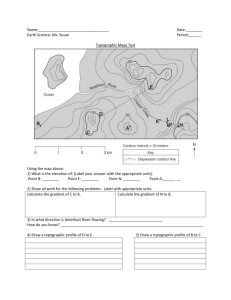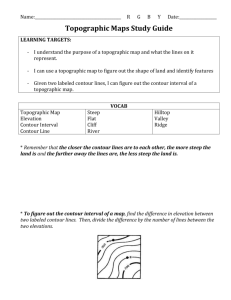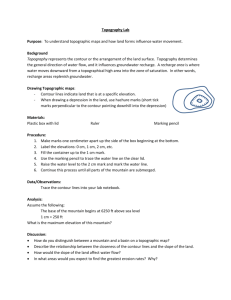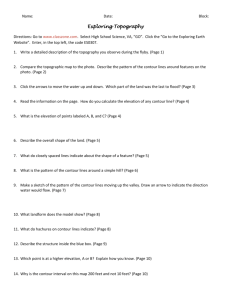Introduction to Topographic Maps
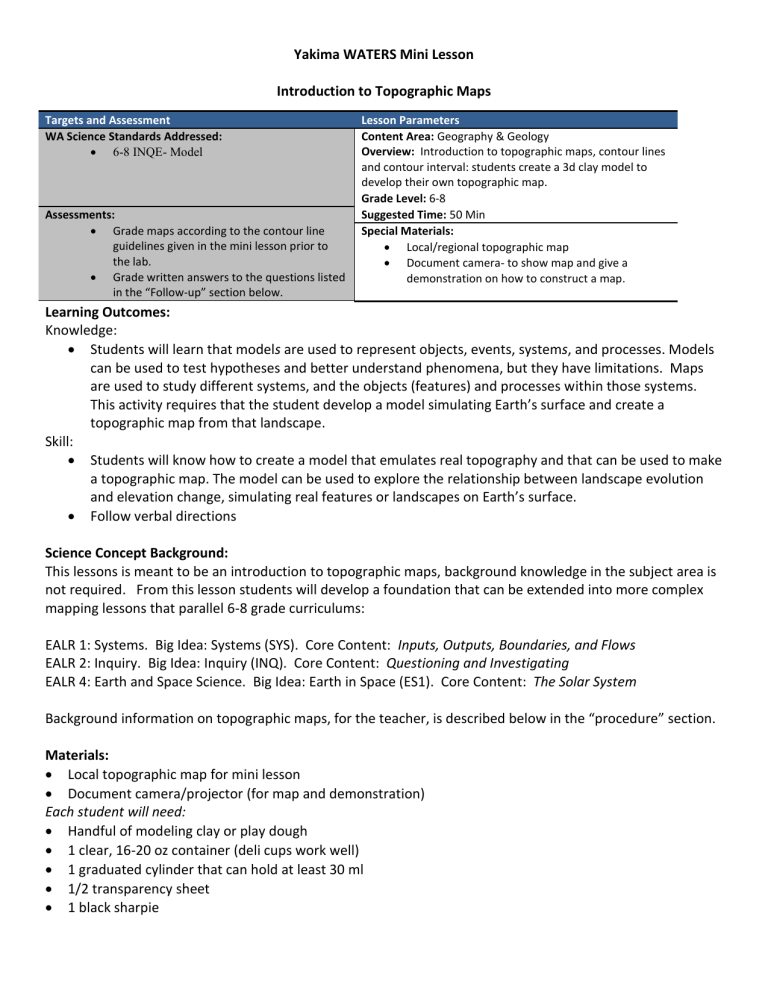
Yakima WATERS Mini Lesson
Introduction to Topographic Maps
Targets and Assessment
WA Science Standards Addressed:
6-8 INQE- Model
Lesson Parameters
Content Area: Geography & Geology
Overview: Introduction to topographic maps, contour lines and contour interval: students create a 3d clay model to develop their own topographic map.
Grade Level: 6-8
Assessments:
Grade maps according to the contour line guidelines given in the mini lesson prior to the lab.
Grade written answers to the questions listed in the “Follow-up” section below.
Suggested Time: 50 Min
Special Materials:
Local/regional topographic map
Document camera- to show map and give a demonstration on how to construct a map.
Learning Outcomes:
Knowledge:
Students will learn that models are used to represent objects, events, systems, and processes. Models can be used to test hypotheses and better understand phenomena, but they have limitations. Maps are used to study different systems, and the objects (features) and processes within those systems.
This activity requires that the student develop a model simulating Earth’s surface and create a topographic map from that landscape.
Skill:
Students will know how to create a model that emulates real topography and that can be used to make a topographic map. The model can be used to explore the relationship between landscape evolution and elevation change, simulating real features or landscapes on Earth’s surface.
Follow verbal directions
Science Concept Background:
This lessons is meant to be an introduction to topographic maps, background knowledge in the subject area is not required. From this lesson students will develop a foundation that can be extended into more complex mapping lessons that parallel 6-8 grade curriculums:
EALR 1: Systems. Big Idea: Systems (SYS). Core Content: Inputs, Outputs, Boundaries, and Flows
EALR 2: Inquiry. Big Idea: Inquiry (INQ). Core Content: Questioning and Investigating
EALR 4: Earth and Space Science. Big Idea: Earth in Space (ES1). Core Content: The Solar System
Background information on topographic maps, for the teacher, is described below in the “procedure” section.
Materials:
Local topographic map for mini lesson
Document camera/projector (for map and demonstration)
Each student will need:
Handful of modeling clay or play dough
1 clear, 16-20 oz container (deli cups work well)
1 graduated cylinder that can hold at least 30 ml
1/2 transparency sheet
1 black sharpie
Procedure:
Engagement & Mini Lesson
Begin by asking your class “what is a topographic map?” and “what is topography?” Have the class share their answers and explain (or repeat if students know) that a topographic map is a type of map that shows the topography or features on Earth’s surface.
Show the class a topographic map (local examples are nice for familiarity) and observe how the local topography is shown on the map. Show/ask the students where they are on the map and invite them to point out any familiar landforms they might recognize.
Then give students a brief lesson on: what contour lines are, what a contour interval is, and how they express topography.
Contour Lines:
Every point on a single contour line represents the same elevation.
Every contour line must eventually connect at its ends- one contour cannot run into or connect to another contour line.
In some cases contour lines will run off of the edge of the map (appearing to not close on itself) in this case the contour has run into the edge of the map and but connects to an adjacent and eventually closes on itself.
Contour lines can never cross one another; each line represents a separate elevation.
Contour Intervals:
Moving from one contour line to another always indicates a change in elevation. That interval is the exact same between each contour on a single map, the scales of maps vary and therefore may be different from map to map.
The closer that contour lines are to one another, the steeper the slope is in the real world (e.g. mountains).
Contours that are spaced further apart represent a shallow to flat slope (e.g. valley).
A series of enclosed contours generally represent a hill or mountain peak. Closed contours that are hachured (short, inward pointing lines drawn perpendicular to the contour line) indicate that there is a closed depression (e.g. crater).
Contour lines crossing a stream valley will form a "V" shape pointing in the uphill (and upstream) direction.
Source:
Idaho State University Department of Geosciences, Introduction to Topographic Maps: http://geology.isu.edu/geostac/Field_Exercise/topomaps/topo_interp.htm
Activity Directions for “Making Your Own Topographic Map”
Step 1: Students go to their lab table/station and collect their materials.
Step 2: Allow ~10 minutes for the students to make their own landscapes. The base of the clay landscape does not have to completely cover the bottom of the container and it should not exceed the top of the container
(Figure 1). It is recommended, however, that the students make relatively simple landscapes that include both high (mountain) and low (valley) topography. The intent is that the landscape will end up submerged in water,
with the highest point of their landscape representing the highest elevation on their topographic map.
Suggestion: After the students have completed their landscapes have them sit back down as a class to watch you demonstrate Step 3 under a document camera.
Figure 1: an example of how the landscape will roughly appear in the container.
Step 3: Looking directly over the landscape carefully place the transparency on top of the container and trace the base of the clay landscape (Figure 2). Once the line is completed label it as 0 ft, this represents the lowest elevation of the topographic map. Now that the students have seen your demonstration on how to draw the first contour line they should be ready to try it on their own. Suggestion: Have students sit back down when their first contour line is drawn, then you know they are ready to see what Step 4 is, which I highly encourage to be demonstrated as well.
Figure 2: demonstration of how Step 3 is set up and the first line is drawn.
Step 4: Next, fill a graduated cylinder to the 30 ml line with water. Pour the water into the container, evenly distributing the water over and around the landscape. The water line will represent a new elevation. Have the students draw their second contour line, this time tracing the landscape/water contact. They should now have two contour lines on their map and the space between the two lines represents a contour interval of 30 ft (Figure 3).
30 ml of water = 30 ft contour interval
Figure 3: addition of 30 ml of water represents the next contour line of 30 ft and a contour interval of 30 ft.
Step 5: Repeat Step 4 until the clay landscape is submerged. Each addition of 30 ml of water will represent another 30 ft in elevation change, so the following contour line would be 60 ft, followed by 90 ft, etc. The final contour will represent the highest peak in their topography.
Follow-up
The following questions could be discussed as a class or hand written and attached to the completed topographic map to be graded.
What is a topographic map?
What is topography?
What is elevation and how is it expressed on a topographic map?
What is a contour line and contour interval?
What kinds of information do topographic maps give us?
Extension(s):
This hands-on activity introduces basic topographic map reading skills and can be followed with more complex lessons that explore map scale and orientation. This lesson is more effective if used as a means to gain student interest and to develop a foundation for understanding topographic maps. Below are links to websites that contain potential follow-up lessons:
USGS Educational Resources: http://education.usgs.gov/common/secondary.htm
Geological Society of America: http://www.geosociety.org/educate/LessonPlans/i_map.htm
Teaching Tips:
Before giving the lesson try to engage the class by asking them what they know about topographic maps, the following websites contain effective and fun questioning methods: http://honolulu.hawaii.edu/intranet/committees/FacDevCom/guidebk/teachtip/teachtip.htm
http://changingminds.org/techniques/questioning/socratic_questions.htm
This small-scale model is a great way for students to explore what contour lines and intervals are, but to avoid any misconceptions about how a topographic map is actually made I recommend briefly explaining the basic process. The following U.S Geological Survey web address, http://egsc.usgs.gov/isb/pubs/booklets/topo/topo.html
, contains an online document describing the history, process and technological tools that are used to produce topographic maps.
Author: Tabitha Trosper, Yakima WATERS Project, CWU, Fall 2010





